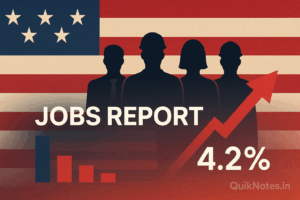Key Points
- Payroll disappointment: Non-farm payrolls rose by only 73 K in July, far below the ~110 K consensus forecast.
- Jobless rate higher: Unemployment inched up to 4.2 % from 4.1 % in June, moving to the top of a narrow 4.0 %–4.2 % band that has held since May 2024.
- Large downward revisions: May and June job gains were slashed by a combined -258 K, suggesting the labor market has been cooler for months.
- Sector splits: Health-care (+55 K) and social assistance (+18 K) provided most of July’s gains, while federal government payrolls fell 12 K.
- Wage growth steady: Average hourly earnings increased 0.3 % m/m (3.9 % y/y) to $36.44; the average work-week edged up to 34.3 hours.
Hiring Stalls as Labor Market Cools
The Bureau of Labor Statistics’ July Employment Situation report shows the slowest payroll expansion since the COVID-era recovery began winding down in 2021. July’s meagre 73 K gain follows a sharply revised 14 K advance in June (initially reported at 147 K) and a 19 K increase in May (down from 144 K). Over the past three months, job growth has averaged just 35 K—a pace many economists view as barely enough to keep employment stable as the workforce ages. Bureau of Labor Statistics
Where the Jobs (and Losses) Were
- Health care (+55 K): Ambulatory services (+34 K) and hospitals (+16 K) continued to hire briskly, reflecting strong demographic demand.
- Social assistance (+18 K): Gains remained broad-based across child- and elder-care services.
- Leisure & hospitality (+5 K): Hiring slowed sharply after a summer surge earlier in the year.
- Federal government (-12 K): Staffing cuts at several agencies erased most public-sector gains. Bureau of Labor Statistics
Manufacturing payrolls were flat, and construction added just 2 K positions despite favourable weather.
Earnings Still Outpacing Inflation—Barely
Average hourly earnings rose $0.12 (0.3 %) on the month, keeping year-on-year wage growth at 3.9 %. That is still above headline CPI (3.3 % y/y in June) but marks the slowest pay growth since late 2022. The average work-week ticked up to 34.3 hours, suggesting firms are trimming head-count before cutting hours. Bureau of Labor Statistics
Fed Policy Implications
July’s soft print—and the hefty revisions—have pushed futures markets to price in an 80 % chance of a 25–50 bp rate cut at the Fed’s 17 September meeting. Chair Jerome Powell said Wednesday that supply-demand conditions in labour “appear balanced,” but acknowledged the data “tilt downside.” Analysts at several banks now expect the policy rate to finish 2025 near 3.75 %. Reuters
Market Reaction
Bond traders bid two-year Treasury yields down 15 bp to 3.79 %, while the S&P 500 opened lower amid renewed tariff concerns and weaker hiring. The dollar softened against major peers on expectations of easier U.S. monetary policy. Financial Times
Outlook
Economists remain divided. Some argue that slower, but still-positive, job creation is consistent with a maturing expansion in which only ~100 K new jobs are needed each month to hold unemployment steady, given weaker immigration and faster retirements. Others see the abrupt down-shift—plus swelling layoff announcements in tech and retail—as a sign the economy is flirting with stall speed. August’s jobs report and the Fed’s September decision will be crucial litmus tests.
